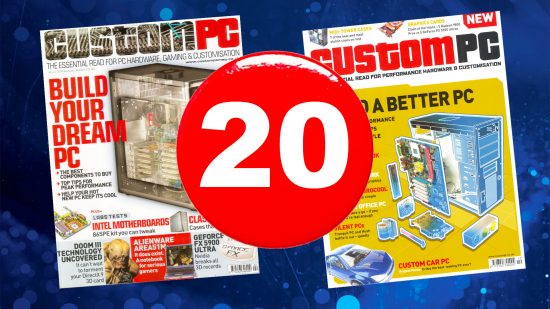Back in the time when dinosaurs walked the earth, a CPU had just one core, and cold cathode lights were all the rage, a bunch of PC hardware enthusiasts decided to launch a magazine devoted to their beloved obsession. Called Custom PC magazine, it aimed to finally serve the many people who loved PC tech gear as a fun hobby, rather than because they were corporate IT managers. Believe it or not, that was at the end of 2003, 20 years ago, and I was there.
Fast forward two decades, and PC hardware enthusiasm has exploded, with companies such as Nvidia and AMD now regularly making the mainstream news. Of course, the print magazine finally had its last gasp at the start of this year, but we’re still regularly serving up the latest in PC hardware news, reviews, and guides on this rather handsome website, after Network N acquired Custom PC earlier this year. Anyway, as it’s our 20th birthday, I thought I’d take us back to 2003 and the very first issue of Custom PC, to see how the landscape has changed.
The start of PC hardware enthusiasm
Extreme ultra! It later became the name of one of our awards, but back in 2003 it was a phrase that members of the PC Pro magazine office (including me) shouted at our colleague Gareth Ogden to taunt him. It’s all a bit embarrassing now. Gareth had taken over PC Pro’s Leisure section – a small part at the back of the magazine to where we relegated our game reviews, and he’d introduced a new ‘Extreme’ page to cover modding and overclocking, where many of the products had ‘Ultra’ in their name.
Games weren’t considered important to most PC hardware magazines at this time. If you were interested in games, you bought a dedicated mag, such as PC Gamer. If you were interested in hardware, most PC magazines for tech-literate folks assumed you were an IT manager or a businessperson. A review of a graphics card was deemed to be a bit of fun that took up less than a page, while most of the space went on the serious PC kit – laser printers, scanners, and everyday PCs. If you were lucky, you might see a 3DMark score on a PC review.
This was all about to change though. By the early 2000s, it was rapidly becoming clear that a huge amount of people were massively interested in PC hardware, and not because they wanted to run Excel faster. The introduction of the first 3D accelerator cards, such as the 3dfx Voodoo, had elevated PCs well above consoles for gaming horsepower, and more and more people were realising that you didn’t have to pay the inflated prices for top-end processors if you knew how to overclock a budget CPU.
People started looking at ways to get more performance out of their PCs. The standard heatsink and fan setup wasn’t powerful enough if you wanted to get the most performance out of your CPU, and we started seeing primitive water-cooling setups based on aquarium pumps, as well as extreme coolers based on refrigeration units.
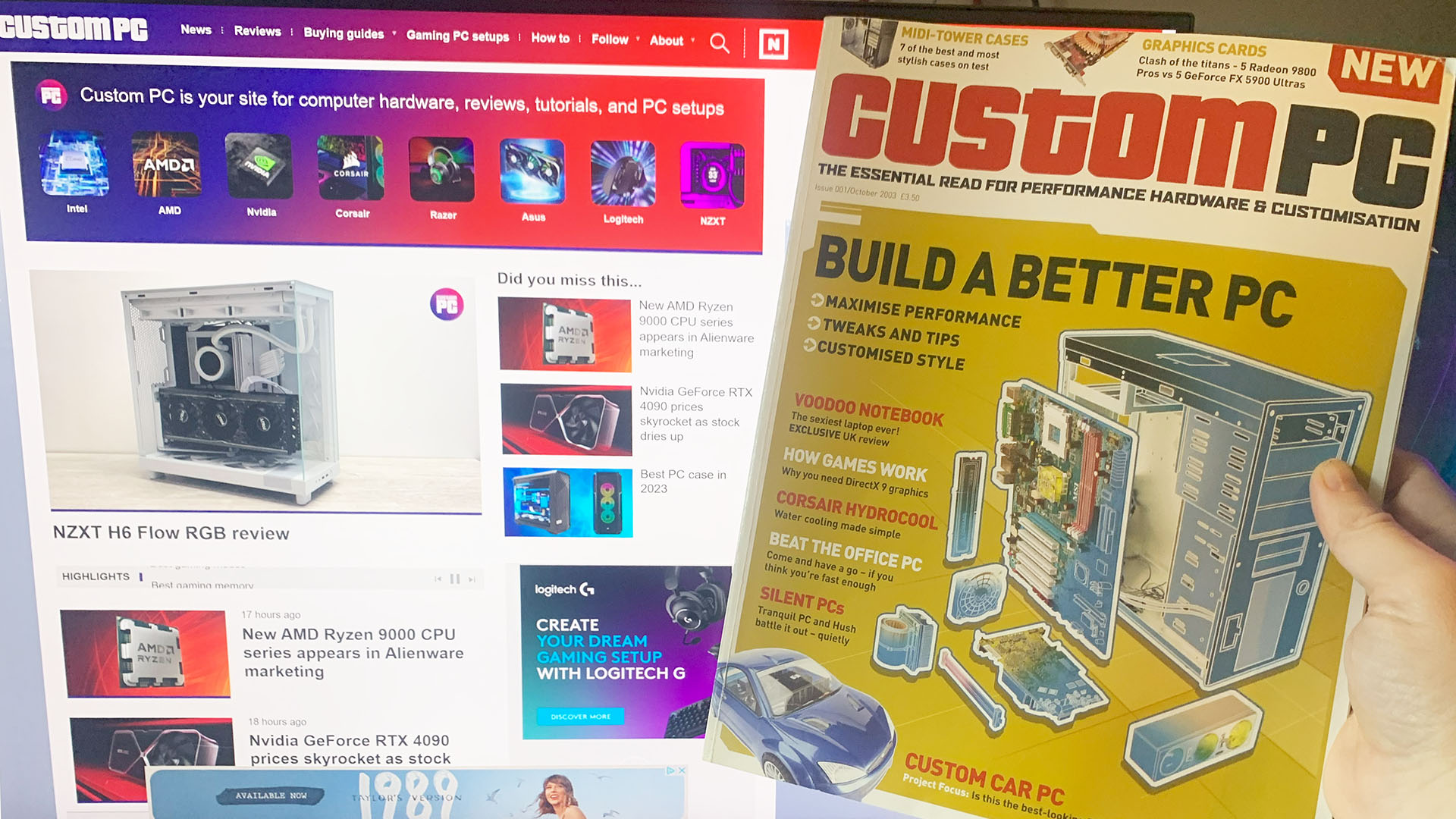
Meanwhile, a rebellion was brewing against the horrible off-white color of PC cases. The original beige color of PC kit might have looked fine in offices and schools, but it looked horrible in the home. To make matters worse, it would gradually become more off-white and progressively yellow as time progressed. To put this into perspective, nobody’s TV or hi-fi equipment was off-white at this time – just computers, alarm clocks, and interior walls.
Enthusiasts started spray-painting their off-white PC cases with automotive paint, and case manufacturers such as Cooler Master and Lian Li began producing silver aluminum cases. A modding community also sprang up around VIA’s EPIA platform – a new mini motherboard standard dubbed mini-ITX, which featured an underpowered VIA CPU, based on the technology acquired when VIA purchased Cyrix. There was a rush to squeeze an EPIA board into various household objects and toys, and ‘PC in a [mundane random object]’ became a theme. We featured one in a toy car in Issue 1.
The genesis of Custom PC magazine
Various websites had sprung up and taken notice of the new trend in PC hardware enthusiasm, from Tom’s Hardware in the US to Hexus and bit-tech in the UK, but magazines were still generally stuck in the off-white, business-focused past. Gareth Ogden pitched an idea to the top folks at Dennis Publishing – a full magazine that took PC Pro’s Extreme section mainstream. It wouldn’t be a catch-all PC magazine that covered everything PC-related, but a specialist hardware enthusiast magazine.
There would be no printer or software reviews, and it would be able to dedicate several pages to a graphics card review if necessary. Meanwhile, the style and design would need to distance itself from the business-like approach of so many other PC magazines. It needed to look and feel more like a dynamic lifestyle magazine you’d have in the lounge than a text-heavy doorstop you’d find on an IT manager’s desk.
The reaction was positive but cautious, and so began several months of exploring and experimentation under the codename ‘Project Hotrod’. Focus groups were assembled, component and PC manufacturers were consulted and a boatload of market research was conducted. During this time, James Gorbold was also recruited into the fold, after previously editing PC Magazine in Dubai.
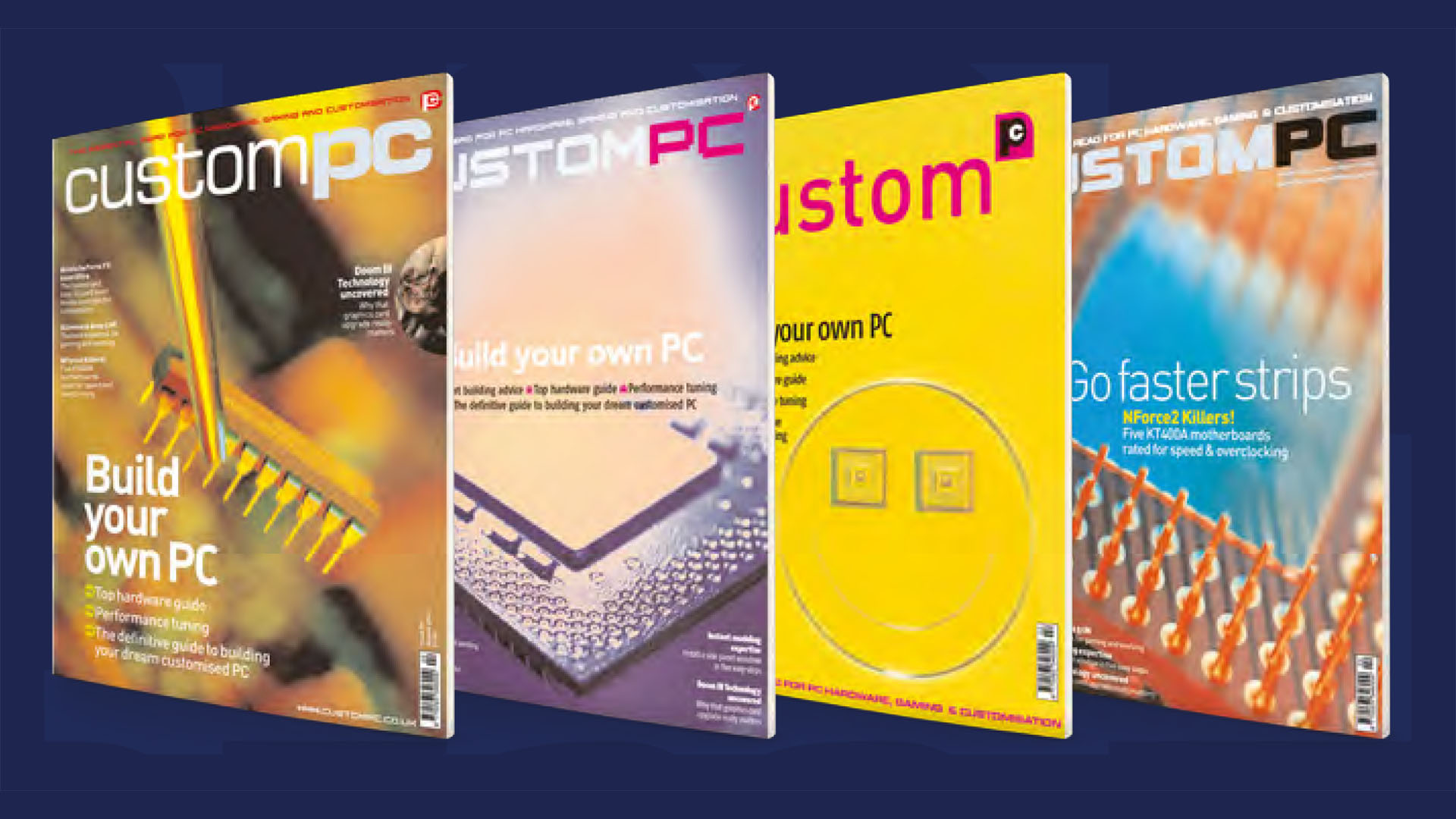
Custom PC was nailed down as the title, and the next step was to settle on a style. Many cover designs were trialed, some of which are shared in the image above, but eventually a logo was designed and a mock issue was made that could be taken to trade shows. Called ‘Issue 000’, it laid the foundation for what was to become Custom PC. By this time, the font had been nailed for the logo (which you can still see at the top of this site), and Gareth and James had settled on a general style of writing and design. The main cover feature, Build your dream PC, also became a regular staple for the magazine over the years.
It wasn’t a full issue. It contained 32 pages that were repeated several times to bump up the thickness, but it covered a bit of all the essentials, including news, reviews, and games coverage. Issue 000 was well received, and work progressed towards the first proper issue.
During this time Julie Birrell was employed as a full-time production editor, while Alex Watson and Josh Blodwell were brought on as staff writers and Daniel Emery edited the games section. The team then worked many long days and evenings on the first issue, recruiting a team of freelancers (including me!) to help out.
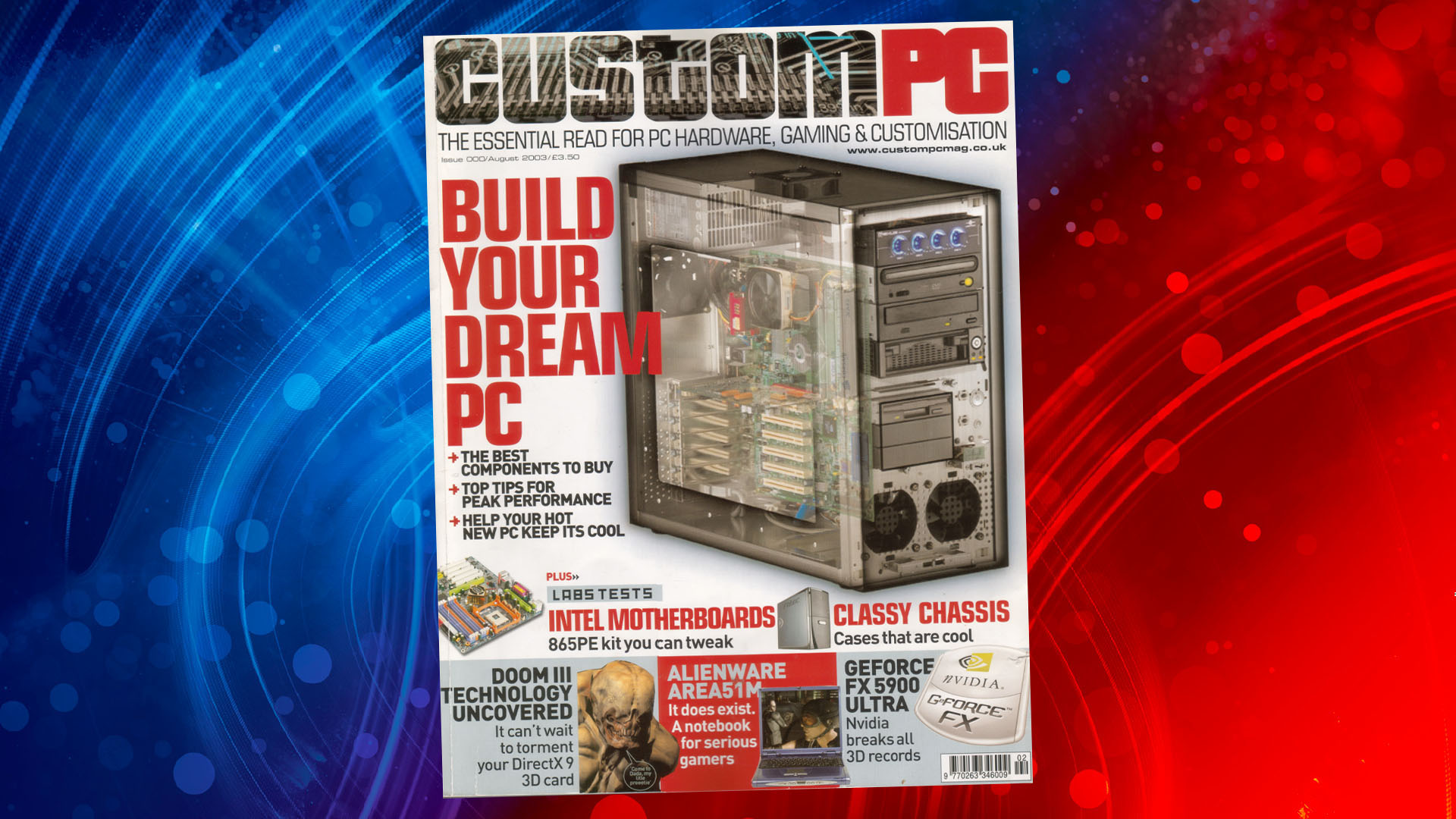
‘We thought it was so advanced and high-tech to be sending files to the printer via ISDN,’ recalls Julie Birrell about the process of assembling that first issue. That’s how long ago this was. In case you’re too young to remember, Integrated Services Digital Network (ISDN) provided an early form of broadband in the UK. Eventually, the first issue went to press, and a bottle of champagne was opened when the last page was finally sent to the printer.
However, if you look closely at the first issue, you’ll also notice a killer typo on the spine, where it says ‘Isuue 1’ rather than ‘Issue 1’, which severely irritated the team who’d spent many long nights working on the first issue.
At this point, news and features were covered on a freelance basis by Stewart Mitchell and Paul Hales, but there was an open space for a full-time role, which I went for. I’d just quit PC Pro and had worked on the first issue of Custom PC as a freelancer, before being brought on as full-time news and features editor for Issue 5. The first full Custom PC team was now complete.
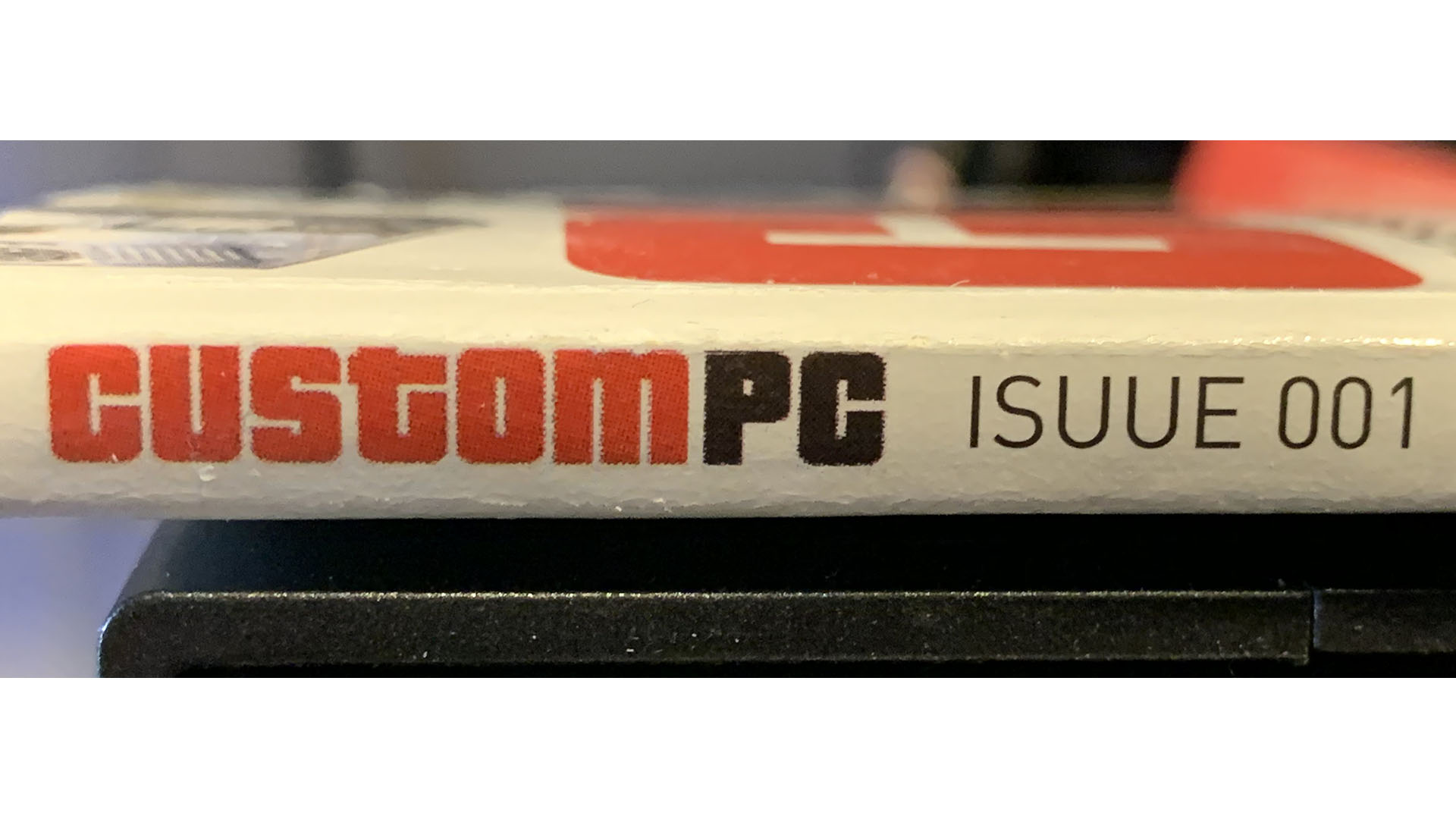
Custom PC nearly gets shut down in first few months
I think it’s okay to talk about this now, but Custom PC didn’t get off to a great start when it was first released. We were really pleased with the content, and the readers liked what we were doing too, but the arty cover designs weren’t selling the magazine on the shelves. The cover for Issue 1 looks subtle and smart with its mustard-colored background, but it doesn’t scream ‘awesome PC hardware!’ You have to look at it for a couple of seconds to see what it’s about.
The writing was nearly on the wall after Issue 4 (on the right in the image below), where the lead cover feature – Windows XP Makeover – was about skinning Windows to customize it to your liking. It bombed. Our publisher called an emergency meeting, and we all agreed that we needed to restyle the cover to go big on photography that properly represented the hardware inside.
Issue 5 (on the left in the image below) sold better, with a few shots of various PC hardware on the front. Then Issue 6, with just one large dynamically angled photo of a dual-channel memory kit, nailed it. Custom PC was now on the road to success – people clearly wanted big photos of fancy circuitboards in their face, and I can’t say I blame them.
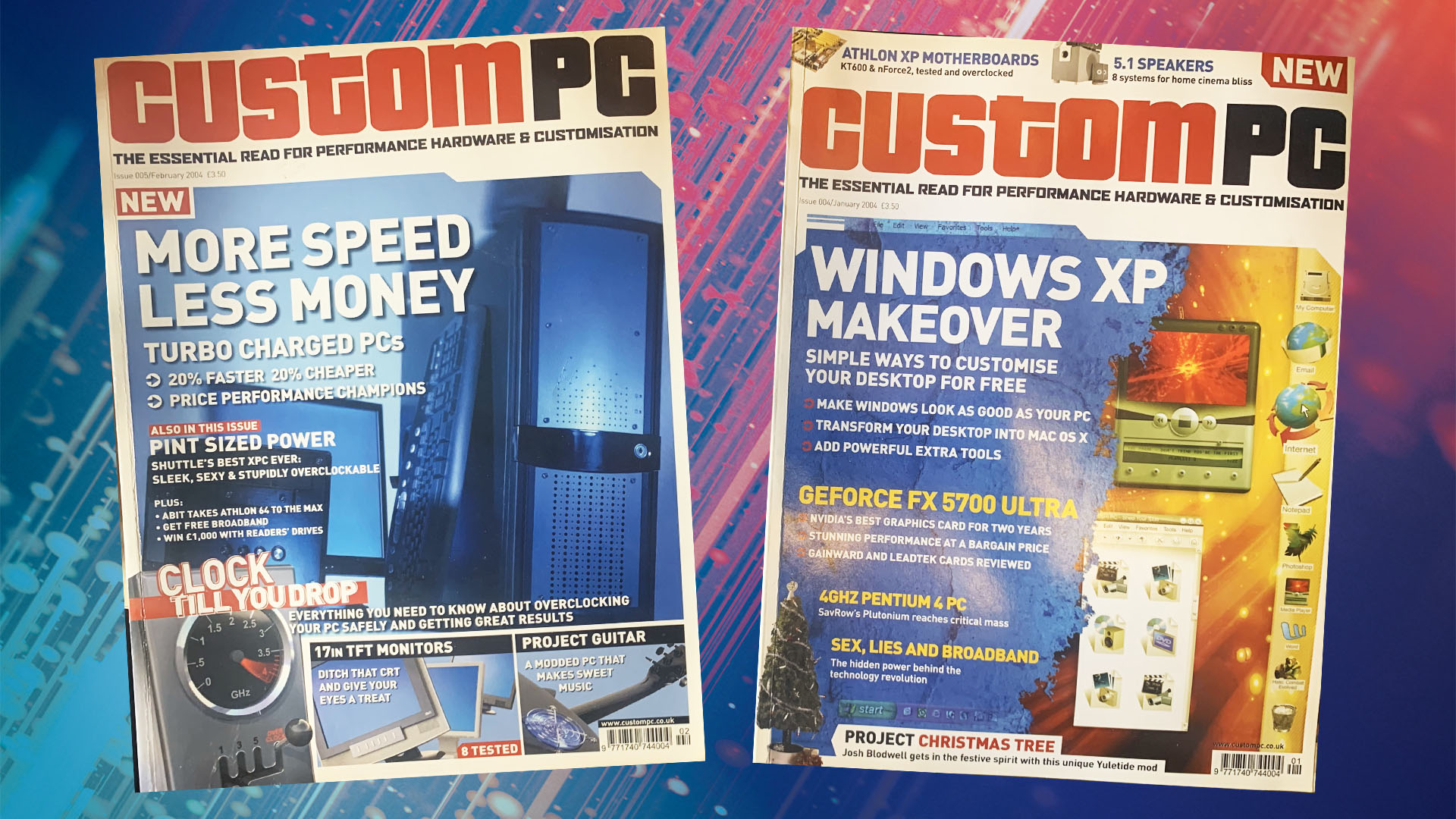
Inside Custom PC Issue 1
So what’s inside the very first issue of Custom PC? Once you get past the contents page, you’re presented with Gareth’s introductory column, where he promises a new PC magazine that doesn’t either assume you’ve never seen a PC before, or that you’re an IT manager. ‘We won’t exclude people by using jargon unnecessarily,’ he says.
‘We’ll drill down to the roots and discover the truth behind the jargon, and what it actually means to you.’ It’s a philosophy that we still apply to Custom PC today. Next follows a lengthy news section, which includes a column by Hexus founder David Ross, a whole page of game news, and an interview with Crucial about the next new exciting standard in memory, DDR2. There’s also a whole page dedicated to ATI’s latest Catalyst GPU driver.
Flick to the Reviews section and you’re immediately presented with one of the key reasons for Custom PC’s introduction – in-depth hardware reviews. The first review dedicates four pages to the Voodoo PC Envy M460 gaming laptop. The Voodoo brand has since been bought by HP, but at this time, Voodoo PC was an independent US system builder headed up by Rahul Sood, who later wrote a column for us.
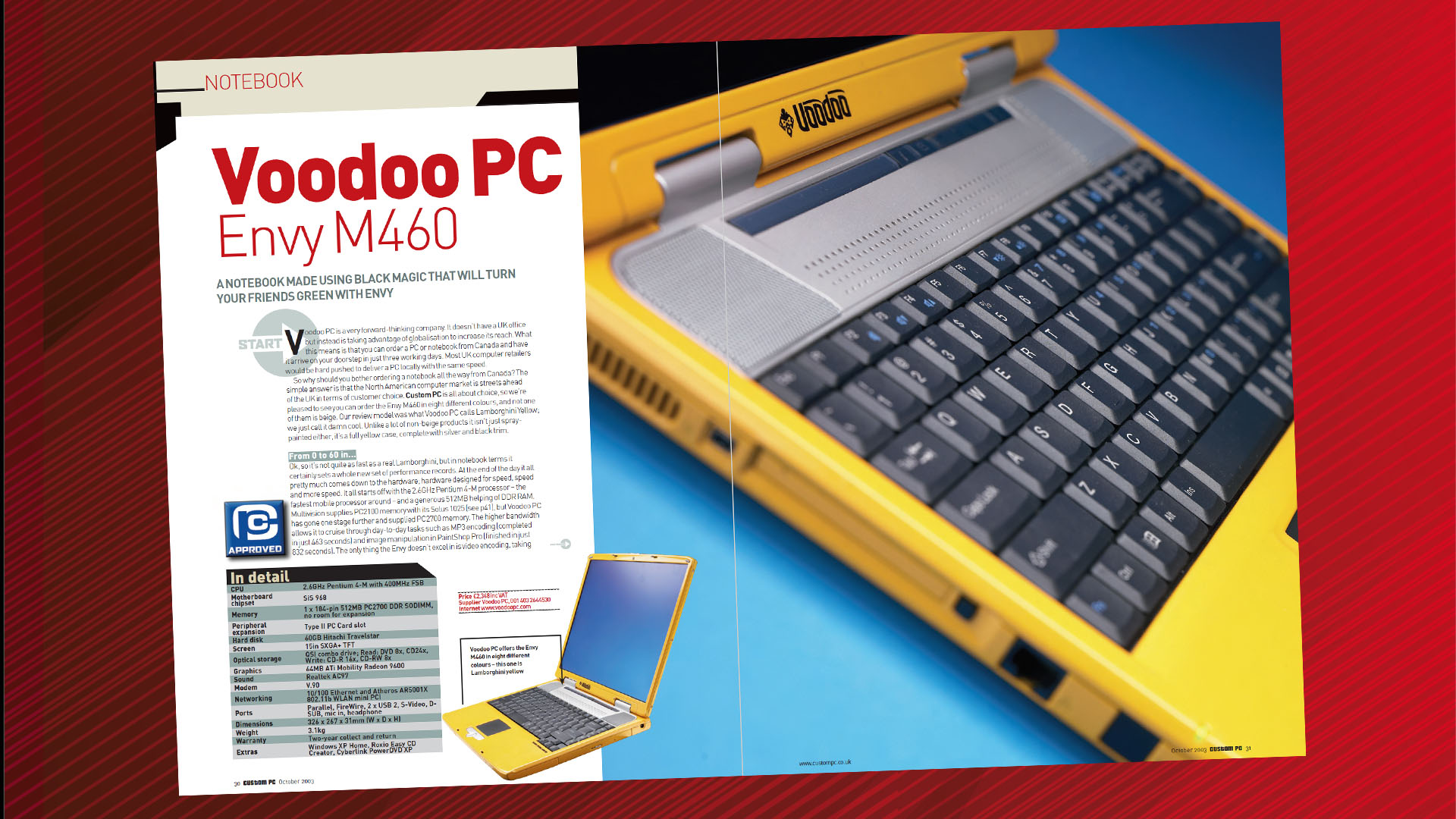
Voodoo PC performed custom mods on cases, with high-quality etching and cutting, while also applying shiny automotive paint finishes. They looked radically different from the usual off-white boxes in other PC magazines at the time. It came with a rugged rucksack for transportation and featured an ATi Mobility Radeon 9600 GPU.
The next few pages feature reviews of prebuilt systems, and these are a bit of an eye-opener, as the side-on shots of the insides are radically different from the ones we feature in PC reviews now. Cable tidying clearly wasn’t a key consideration at the time, even for enthusiast case manufacturers. The Scan 3XS-H reviewed in issue 1 is built inside a Cooler Master Wave Master case, which looked fine on the outside, but had few of today’s case features on the inside, as you can see in the pic below.
The PSU is mounted in the top rather than the bottom, the motherboard has a standard yellow-colored PCB and there are cables all over the place. They’re neatly bunched together and tied to the chassis where possible, but there was clearly no way to easily hide cables at this time – there are no tidy rubber-grommeted cable-routing holes around the motherboard tray, and there’s no PSU shroud. Plus, the yellow, red, and black PSU cables look radically different to the sleeved and braided PSU cables we see now.
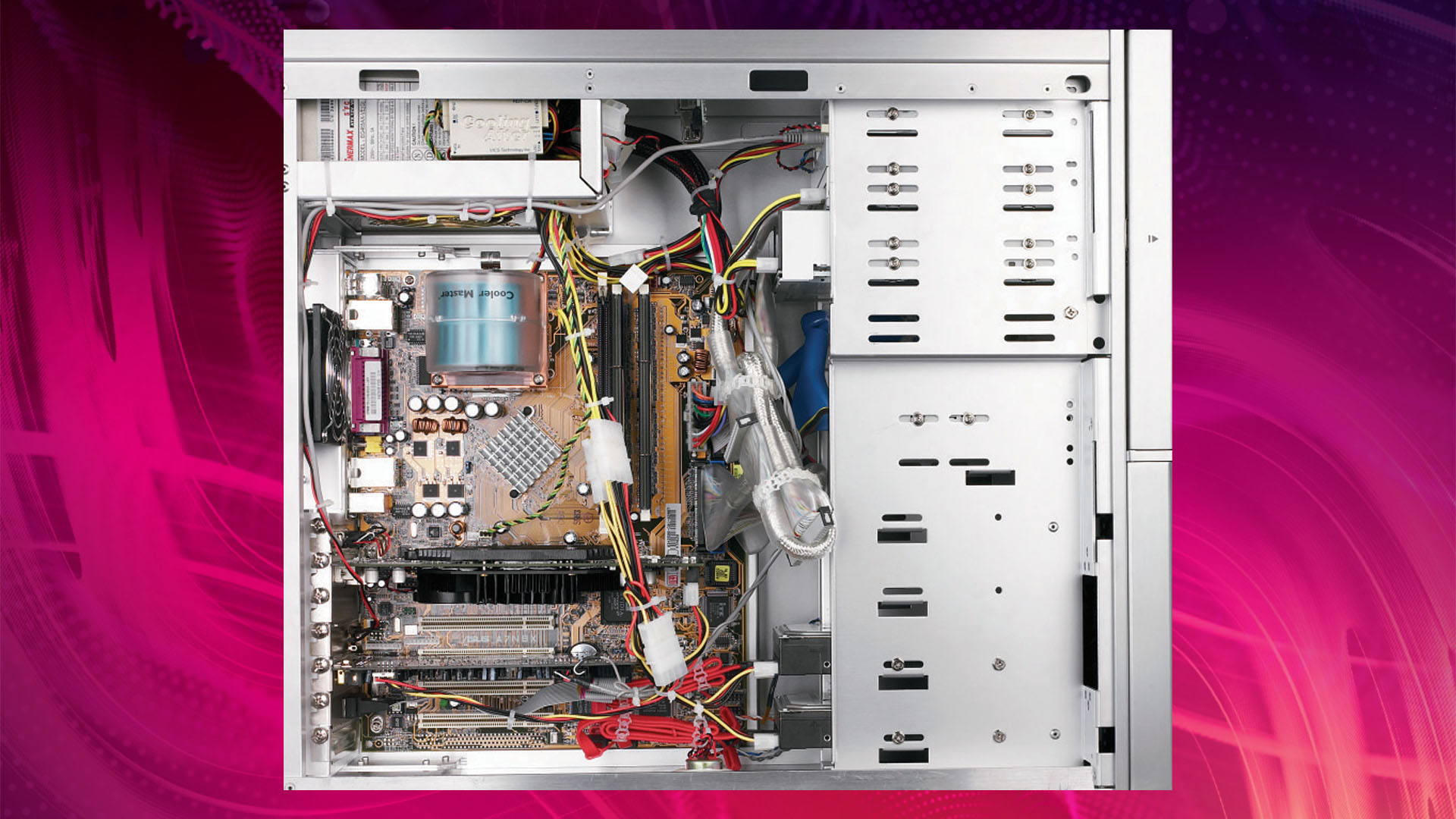
At this time, we were still heavily using Molex connectors to all sorts of gear, from fans and hard drives to cold cathode lights. The Scan PC in Issue 1 is filled with various Molex cables linked to splitters and adaptors. It also features cables for both SATA and IDE storage. The latter was a problem at the time for cable tidying at the time, as the standard flat IDE ribbon cables were ugly.
You could route them under your motherboard if the standoffs had enough clearance, but an alternative that had just been introduced at this time were ‘rounded’ IDE cables. These still had the bulky 40-pin connectors on either end, but then squeezed the wires into a bunch so it looked like a chunky round cable, rather than a flat ribbon cable.
In terms of spec, we’ve clearly come a long way as well. The Scan 3XS-H came with an AMD Athlon XP 3200+ CPU (which was only 32-bit), 1GB of Corsair PC3700 dual-channel RAM and a pair of 120GB hard drives in a SATA RAID array.
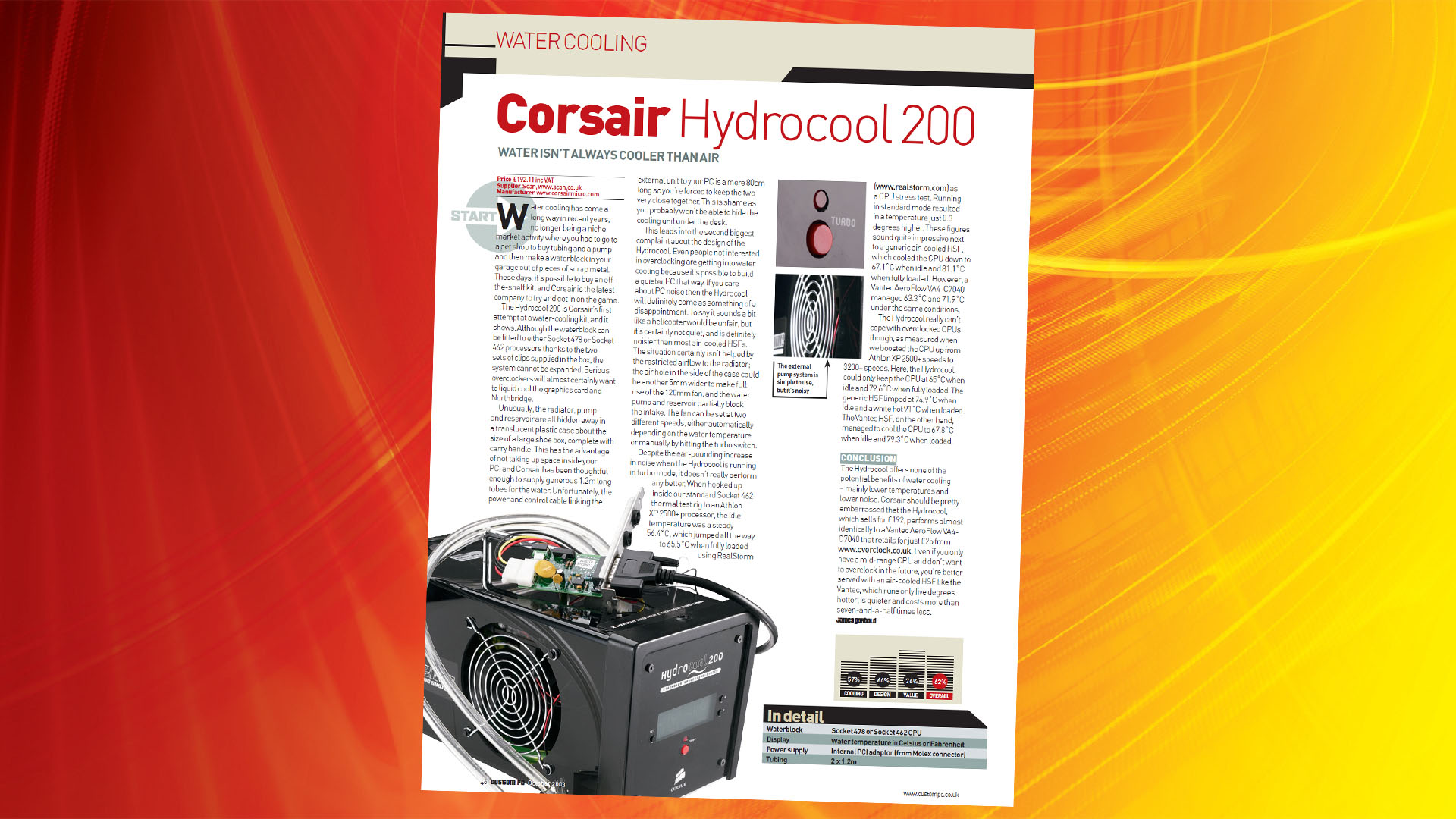
Another noteworthy review in Issue 1 is the first liquid-cooling system to come from Corsair, the Corsair Hydrocool 200. It used a massive external pump unit and it cost nearly $200. That would have been fine if it worked well, but it was barely any better than a top-end air cooler and it made a lot of noise. We recommended buying a $25 Vantec AeroFlow air cooler instead.
Finally, there’s a great product at the end of the reviews section that I’d forgotten about until recently – the Cooler Master Musketeer. This module fitted into a spare 5.25-inch drive bay and presented you with three analog needle meters – one for temperature (with a sensor probe you would attach to a chip yourself), one for voltage, and one for sound pressure, with the latter being connected to your sound card via analog cables around the back. It didn’t have much of a genuine practical purpose, but it gave a lovely retro analog touch to your PC case.
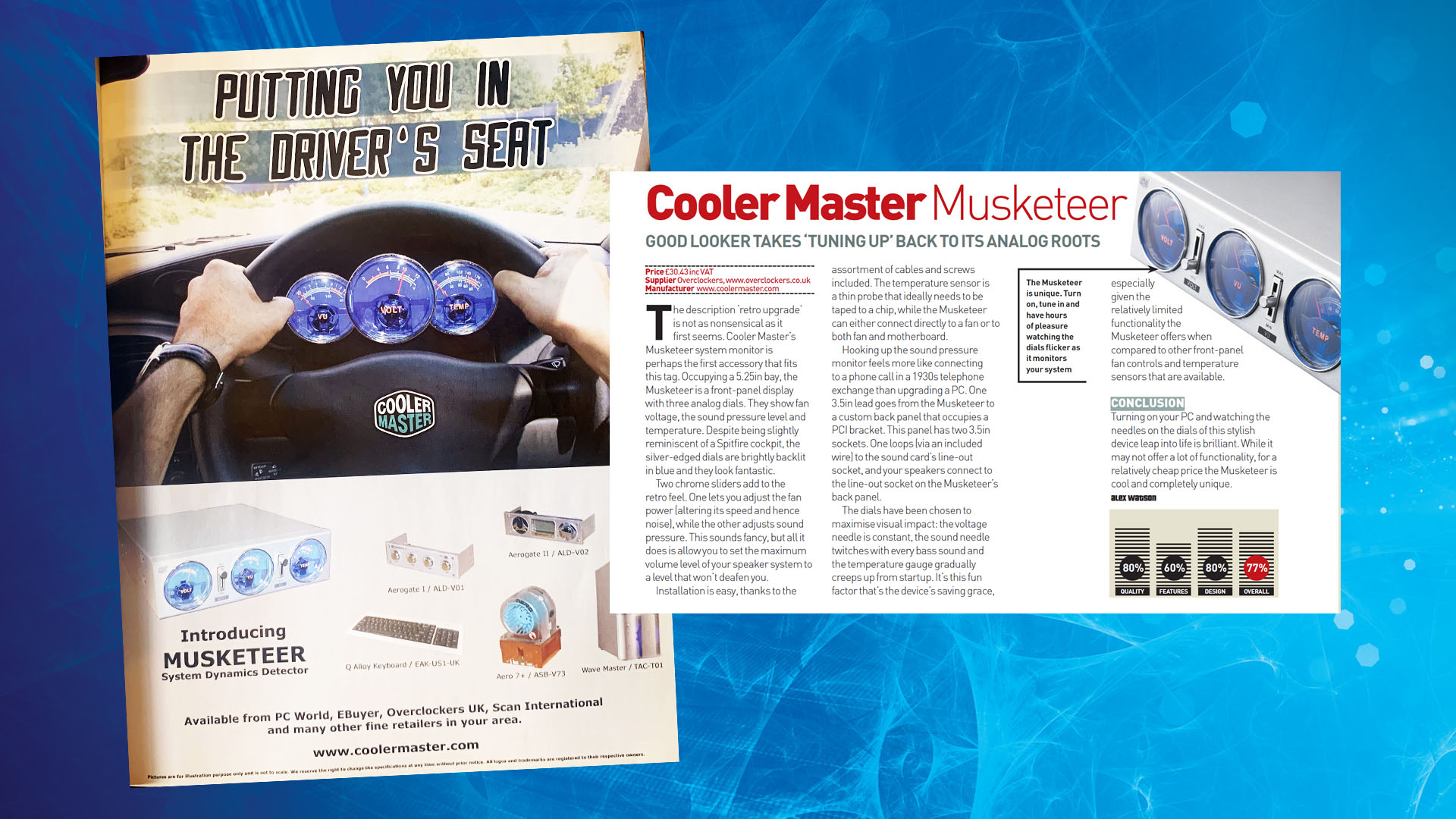
There are two group tests in issue 1. The first is on cases, which reveals more of the same issues with cases seen in the PC reviews. Case manufacturers had clearly started to notice that there was a market for non-beige, but there was still a lot to learn. Nearly every one of the cases featured comes equipped with 80mm fans, and we made it our mission to persuade people to use 120mm fans instead, so you could get more airflow at a slower rotational speed, helping to avoid the horrible high-pitched noise often generated by smaller fans.
One case on test, the Beantech BT-80, is notable for being completely transparent with three horrible 80mm fans. ‘If you want a transparent case to show off the internal components, you have to be prepared to accept the shortcomings,’ we said, ‘oh, and buy a pair of ear muffs.’
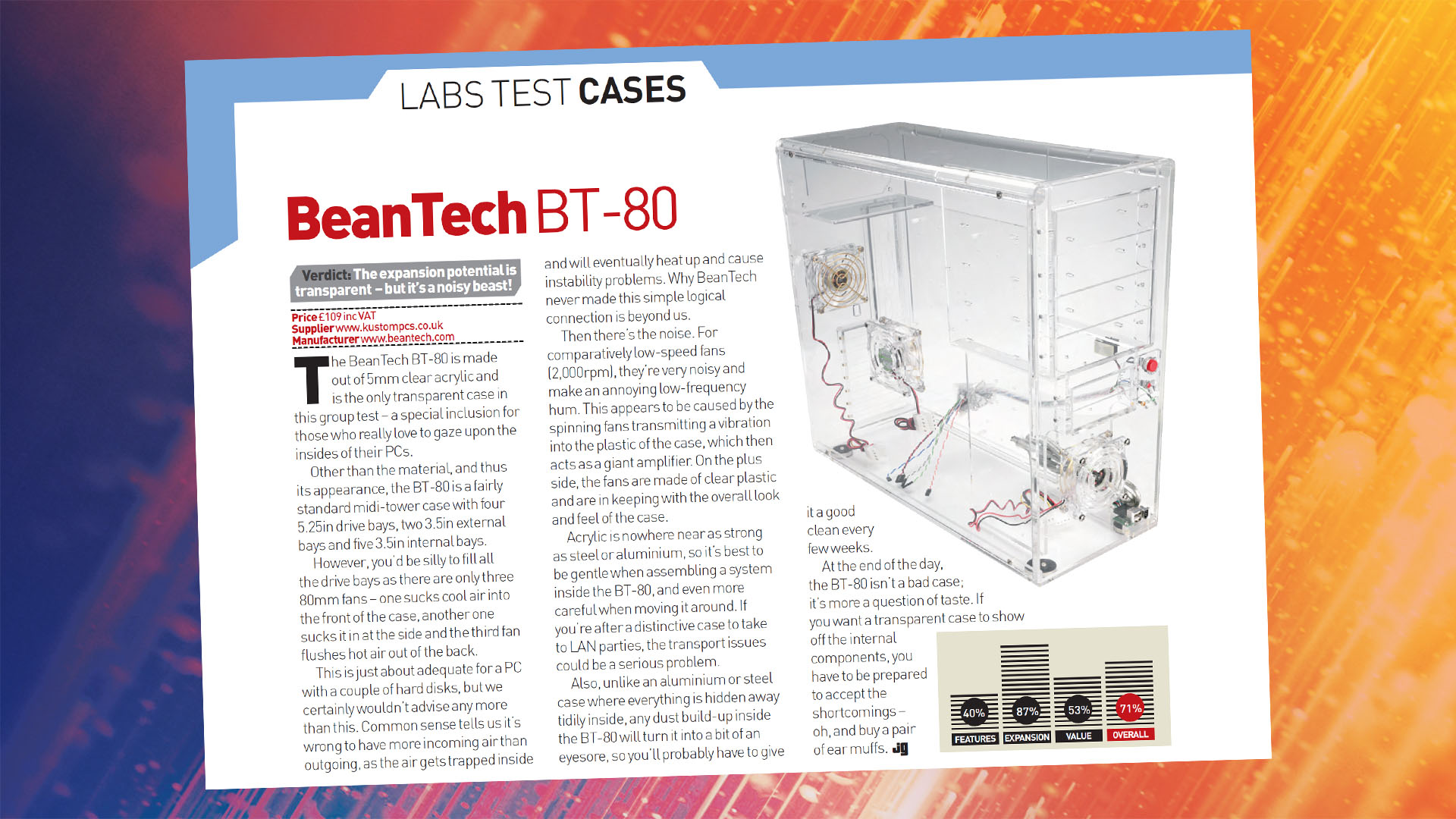
The other Labs test was graphics cards, all of which were either based on the Nvidia GeForce FX 5900 Ultra or ATI’s Radeon 9800 Pro. The latter was the superior GPU at the time, but all the cards are quite different from today’s monsters.
Both these GPUs were considered top of the range in 2003, but none of the cards has enormous coolers. There’s usually a small heatsink and fan on the GPU, and nearly all of them take up a single expansion slot bracket. A notable exception is the Sapphire Atlantis Ultimate Edition, which has a large passive heatsink with no fan.
All the cards on test also have an accelerated graphics port (AGP) slot connector. At this time, motherboards came with a dedicated high-speed slot for a single graphics card, and PCI slots for extra expansion cards.
Finally, we come to the features, and the main one is ‘Build a better PC’. Here we take you through which CPU to buy for various budgets, covering both Intel and AMD or options, and we also help you decide which type of display you need – an LCD or a CRT monitor. As with so many of the reviews in this issue, a large chunk of the feature is dedicated to tidying cables.
So many cables were required at this time, and they looked horrible. In the feature, we recommended using plastic spiral cable wrap to keep your cables together and make them look better. ‘The more adventurous can buy neon-colored cable management kits,’ we said.
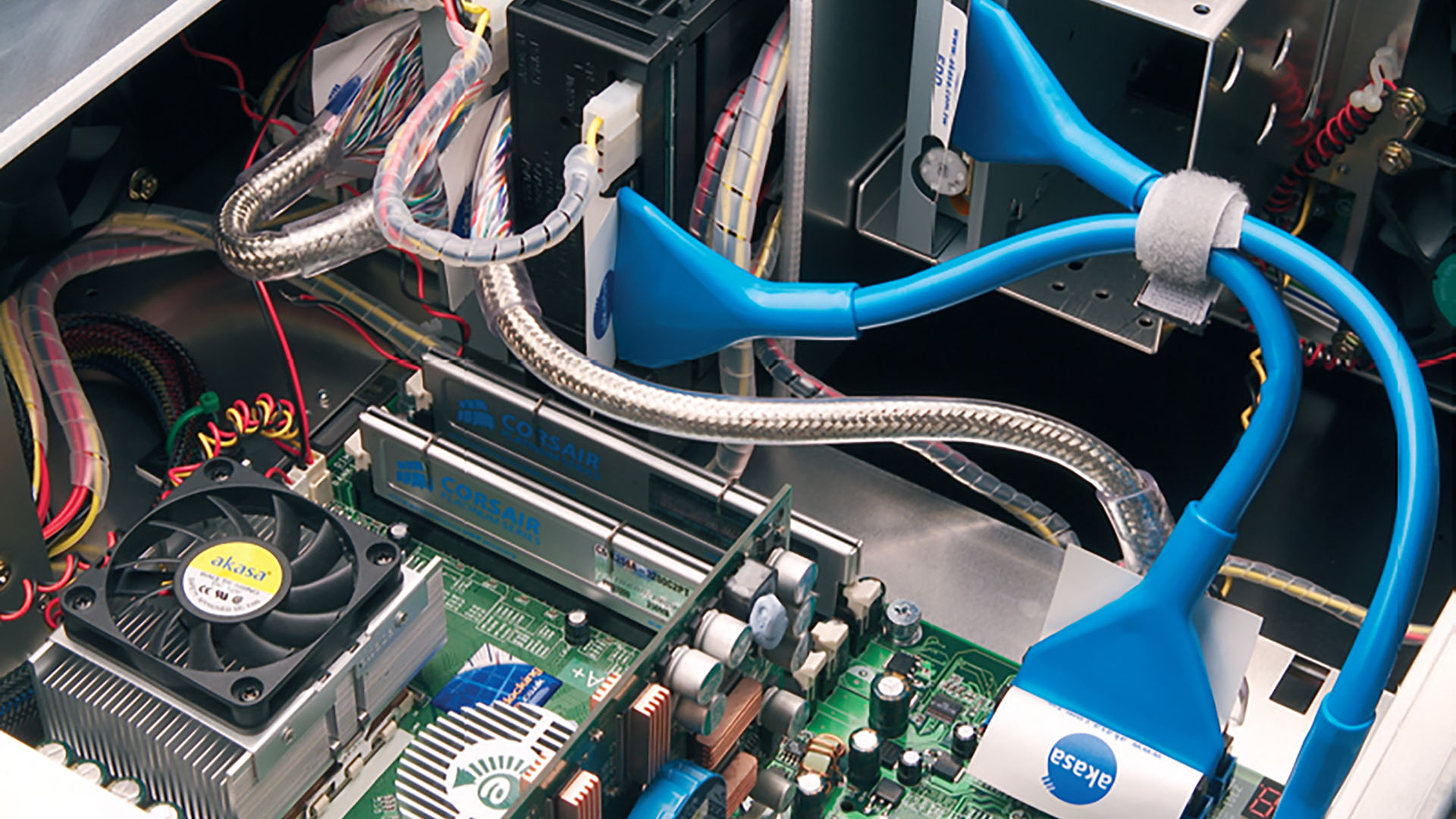
Meanwhile, the extreme customization feature was Project Focus, a model Ford Focus that had been modded to accommodate a basic mini-ITX system. As we mentioned earlier, though, mini-ITX was very different at this time, being dominated by VIA’s EPIA platform with integrated CPUs – the processor in Project Focus only has a 533MHz clock speed.
Finally, at the back, there’s the Beat the Office section. Here, we built an overclocked system with a phase change cooler (basically a refrigeration unit). We ran our own benchmark suite on it, using open source freely available software, and challenged you to build a system that would beat its results – you could apply to receive a CD with our benchmarks on it in the post, with a £5 fee. If you won, you would take home the actual Beat the Office machine itself.
The problem was that the only people who stood a chance of winning were the ones with the enormous amounts of money needed for top-end cooling systems and components, which alienated most of our readership. One day, we’d love to bring back a proper benchmarks leaderboard, though, as well as updating our benchmark suite.
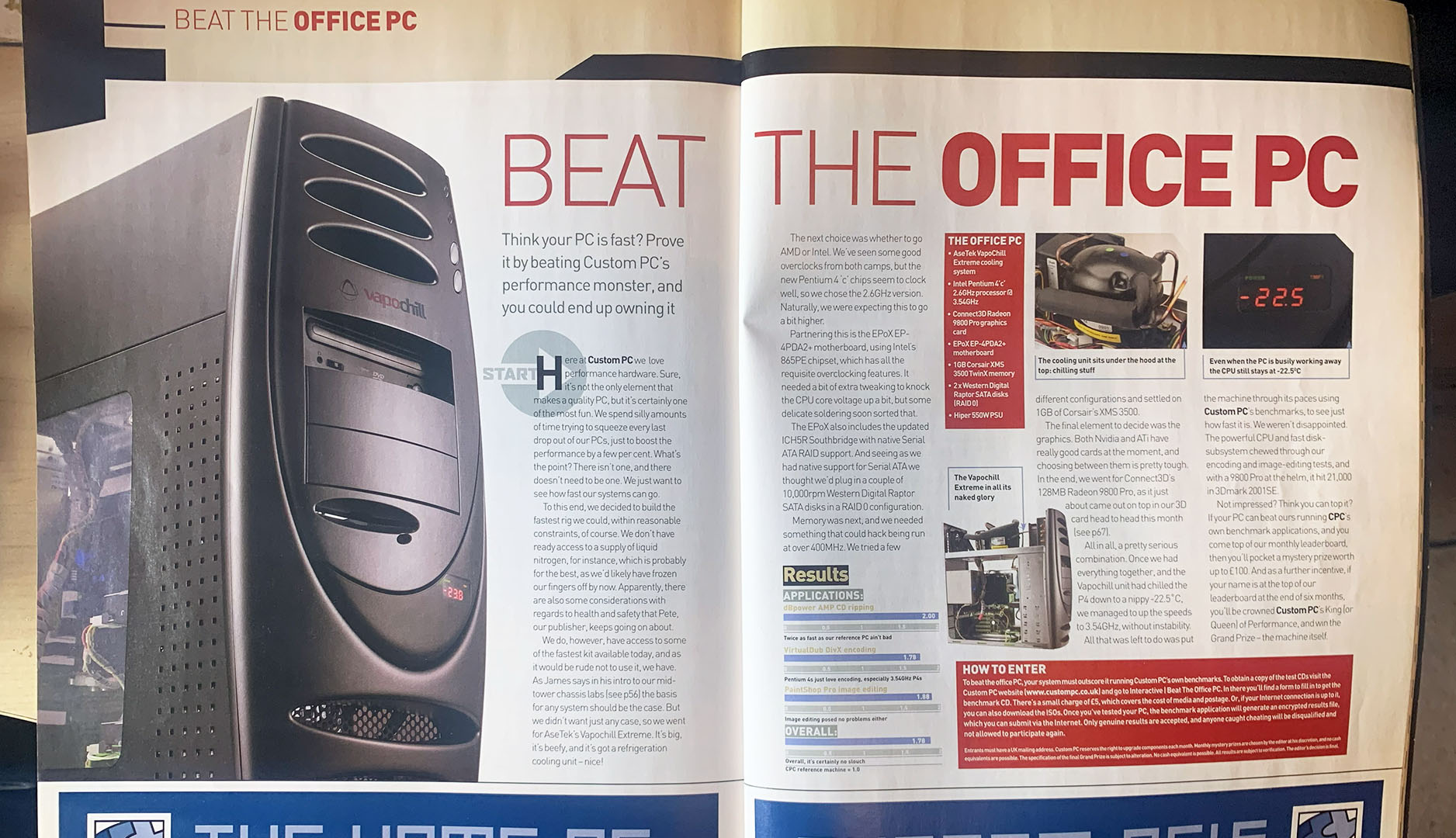
What happened to Custom PC magazine?
After 15 years at Dennis Publishing (which is now owned by Future Publishing), Custom PC magazine was sold to Raspberry Pi Ltd, where it was given a new lease of life for a few years, with some more investment and better-quality paper.
However, the impact of Covid lockdowns had a dramatic effect on newsstand sales – it’s hard to sell a magazine when it’s illegal to open the places that sell it. Custom PC magazine made it through to the other side, but was then hit by rocketing print costs, which sadly eventually made it unprofitable to make the magazine any more.
In February 2023, Custom PC was snapped up by Network N, where the existing editorial team members were all given new jobs on this website, and we’re very happy to be able to carry on doing our good work online. Custom PC is still here 20 years after the first issue rolled off the press, and long may it continue.
We hope you’ve enjoyed reading this retrospective on the early days of Custom PC, and exploring our first issue of the magazine with us. For more articles about the PC’s vintage history, check out our Retro tech page, as well as our full guide on how to build a retro gaming PC, and our piece on the Intel Pentium 4, which was Intel’s flagship desktop CPU architecture in 2003.
